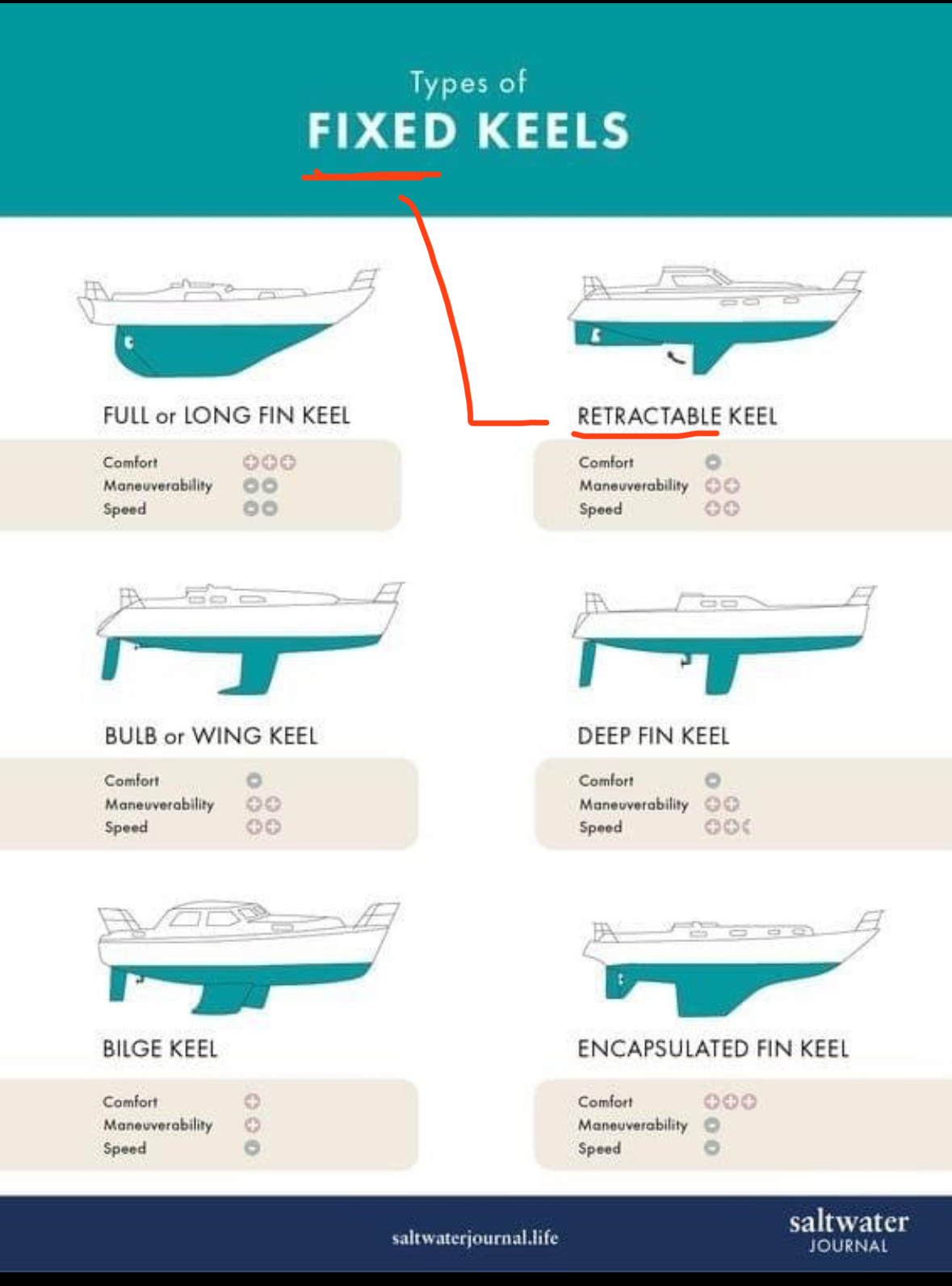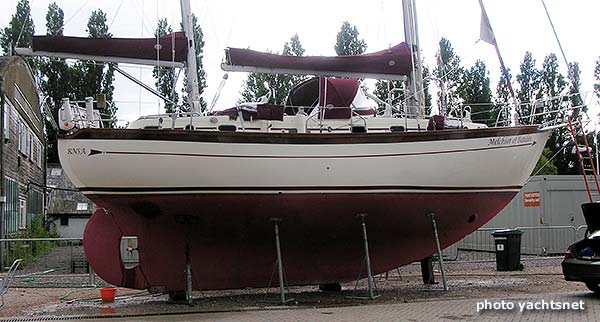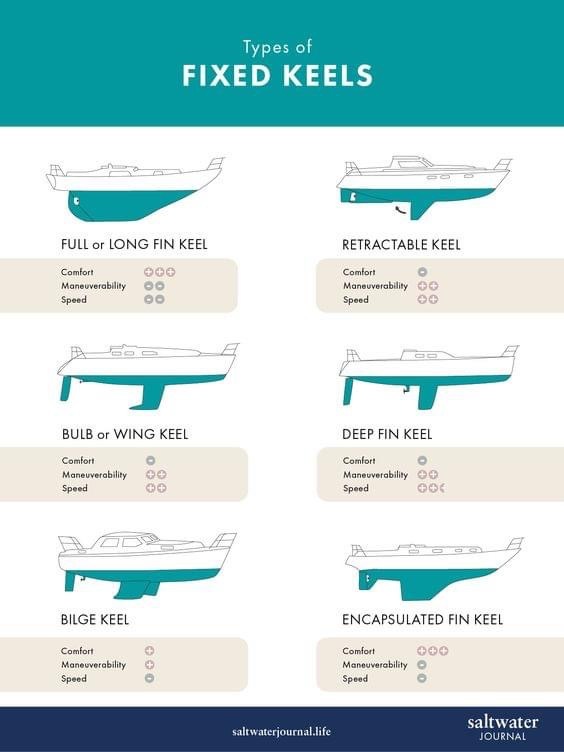Types of fixed keels: Retractable
Waiting for the guide on retractable keels..
Types of retractable keels: Fixed
Its still fixed to the hull just not fixed in position...?
Are there keels that are not fixed to the hull?
Not fixed while in operation, no (if it's not rigidly mounted it can't apply torque to the hull). Not fixed permanently, yes: they're called "daggerboards."
Yes, a daggerboard. It’s like a centerboard keel, but slides through a slot instead of swinging up into the hull.
I don't think so. A daggerboard or centerboard has a similar purpose, but by definition is not a keel.
“Fixed” refers to the fact that the keel isn’t removable. It’s either part of the boat’s hull, or it’s bolted on and can’t be removed without dry-docking the boat.
There are some boat designs with removable keels. For instance, many small sailboats (called a dinghy) have removable keels, so you can remove the keel and beach them easily. The downside to having a removable keel on a sailboat is that it makes the boat prone to capsizing in strong winds; A fixed keel can have a built in ballast to keep the boat from tipping. But on a dinghy, you need to use a live ballast (literally your own body weight leaning out of the boat) to counteract the wind’s effects.

Isn't a non weighted and removable „keel” on small sailing dinghies called a „dagger board” and is there only for mitigating drift?
That's some fun stuff though, especially on a catamaran when one of the two hulls is entirely is up in the air.
but…

It retracts, but it's fixed to the hull, it is not removable.
One neat unmentioned advantage of a bilge keel is that it often enables careening without having to tip the boat on its side or use stands to prop it up.

I also feel like this cool guide should mention differences in draft between different styles of keel.
The first entry “full or long fin keel” is technically a modified full keel with a cutaway forefoot. A true full keel would have the keel extending almost in a straight vertical line from the stem to intersect the horizontal line of the bottom of the keel.

The modified full keel is a nice compromise between the comfort and stability of a full keel and the maneuverability of a fin keel.
Both types of full keel benefit from having a fully protected propeller in an aperture and the additional safety and security of a fully hung rudder. Additionally, nothing beats a full keel for rock solid dependability as the keel is molded into the hull, whereas a fin keel is generally attached by bolts, a far less structurally reliable method.
Neither can compete for speed or maneuverability with a fin or bulb keel for several reasons, not the least of which is far more additional wetted hull area and the water friction inherent therein.
I could be mistaken, but I believe this is the first time I’ve ever seen “full” and “fin” used to describe the same item. I believe those are mutually exclusive terms.
Ngl, I'm at half chub from a comment like this that expands on something cool with even more cool detail
Lol, in that case, I regret for once not divulging the unsolicited full info dump for fear of growing preachy/pedantic. We might’ve achieved full arousal!
Thought this was a meme about how boats would wear pants for a second
The tier list is missing some stat that would explain why anyone would use the bilge keel
Tides
Yeah I was wondering the same. The first thing that came to mind is it’s probably the cheapest?
Does having a keel imply that the ship is self-righting? Like, completely submerged, does it also guarantee that the ship floats back to the top, oriented?
Yes. They are weighted with lead, and help keep the boat topside-up. They are also a critical component to the functioning of sail propulsion. The keel works in a kind of opposition to the sail to propel the boat forward, similar to how squeezing an ice cube between your thumb and finger will 'squirt' it out in a direction perpendicular to those forces.
But also no, if it's capsized, the boat may right itself in time before it floods to a point where it sinks.
A fully submerged boat will not bob to the surface. The keel adds stability and (counter)weight, but negative buoyancy - what keeps the boat afloat is the air in the hull.
Once it's fully submerged, there's nothing pulling it up (unless you have some seriously good (and closed!) hatches...
Cool Guides
Rules for Posting Guides on Our Community
1. Defining a Guide Guides are comprehensive reference materials, how-tos, or comparison tables. A guide must be well-organized both in content and layout. Information should be easily accessible without unnecessary navigation. Guides can include flowcharts, step-by-step instructions, or visual references that compare different elements side by side.
2. Infographic Guidelines Infographics are permitted if they are educational and informative. They should aim to convey complex information visually and clearly. However, infographics that primarily serve as visual essays without structured guidance will be subject to removal.
3. Grey Area Moderators may use discretion when deciding to remove posts. If in doubt, message us or use downvotes for content you find inappropriate.
4. Source Attribution If you know the original source of a guide, share it in the comments to credit the creators.
5. Diverse Content To keep our community engaging, avoid saturating the feed with similar topics. Excessive posts on a single topic may be moderated to maintain diversity.
6. Verify in Comments Always check the comments for additional insights or corrections. Moderators rely on community expertise for accuracy.
Community Guidelines
-
Direct Image Links Only Only direct links to .png, .jpg, and .jpeg image formats are permitted.
-
Educational Infographics Only Infographics must aim to educate and inform with structured content. Purely narrative or non-informative infographics may be removed.
-
Serious Guides Only Nonserious or comedy-based guides will be removed.
-
No Harmful Content Guides promoting dangerous or harmful activities/materials will be removed. This includes content intended to cause harm to others.
By following these rules, we can maintain a diverse and informative community. If you have any questions or concerns, feel free to reach out to the moderators. Thank you for contributing responsibly!
